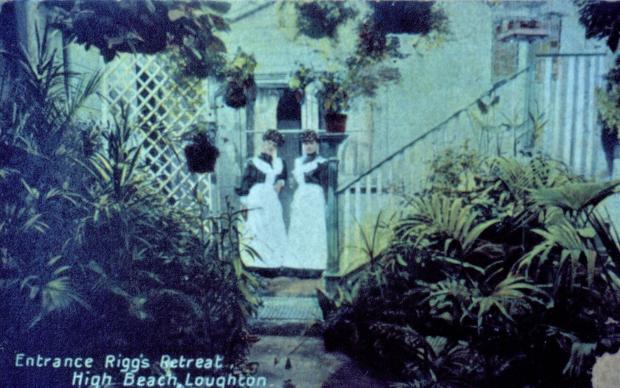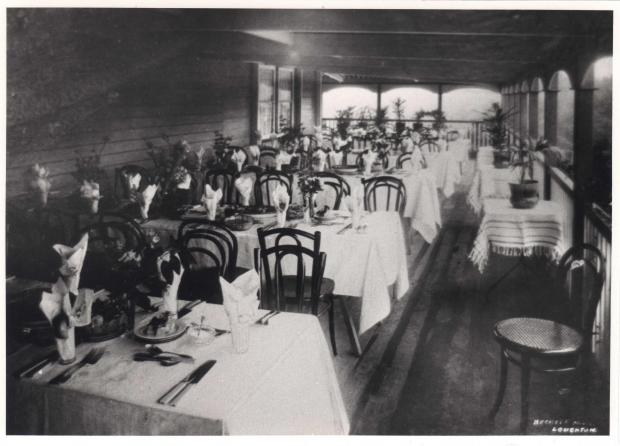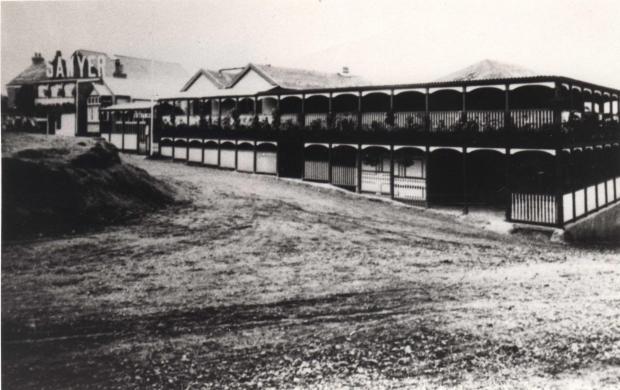Towards the end of the 19th century London was expanding rapidly with cramped housing for people who worked long hours. Epping Forest became the playground of East London with the cockneys coming on foot, by wagonette, in horse-brakes and by train. On the Whitsun Bank Holiday in 1903, it was estimated that 100,000 people were enjoying the sunshine and fresh air of Epping Forest, 16,000 of them coming via Loughton station. They found many attractions such as swing-boats and roundabouts, coconut shies and donkey rides.
It was John Riggs who first had the idea of a ‘retreat’ – a large building where vast numbers of people could obtain non-alcoholic refreshments. This became popular for the many outings of church groups and others sponsored by charitable organisations. Riggs built three retreats which were run by three of his sons. Soon other retreats opened, and these facilities must have been enjoyed by literally millions of Eastenders over the years.
Holiday time in the Forest c1875
Typically, children paid a ha’penny each week to their Sunday School so that every 13 weeks they had a party or treat such as to the fair at Chingford Plain. There were roundabouts, donkey rides, swings, etc for ha’penny a turn. Then they had tea at Butlers Retreat. The saved 6½d would pay for bread and butter, with jam on the table, a slice of slab cake (fruit cake, seed cake or plain cake) and a cup of tea.
 Maids stand outside the entrance to Riggs Retreat
Maids stand outside the entrance to Riggs Retreat
However, if an outing to a retreat was a great treat to many, it was not so much fun for those who lived there. Sydney Riggs (born 1891) was the second son of William Riggs and he described life at the High Beach retreat run by his father.
“The retreat itself was a spacious wooden building accommodating hundreds of patrons with the family living quarters situated in the west wing, the balance being a series of tearooms terminating in the east wing with permanent domestic staff. The normal ‘tea’ was bread or milk rolls, butter; jam, watercress and lettuce; a variety of cut cake; unlimited cups of tea, all backed up with a swift, efficient waitress service; price 9d (3½p)
 Inside Riggs Retreat at High Beach
Inside Riggs Retreat at High Beach
“In the high season a 16-hour day was usual, as the customers poured into the retreat every day from March to September, year in and year out. Horse-drawn brake loads of humanity, a few of better class but mostly under-privileged (and unwashed!) were collected from Chingford Station. Incredibly, this was accomplished before electricity, gas or piped water were available. Light and heat were provided by coal and paraffin. Water came in relays of horse-drawn carts, bringing water from the well situated about a mile distant towards Waltham Abbey. It was not until 1907 that piped water finally arrived at High Beach.”
Mrs Dora Punchard remembered working at Sawyers when she was about 10 years old, circa1912. “I worked on a Saturday afternoon in the cloakrooms of the tearooms next door to Riggs Retreat, which was Sawyers Retreat. I had to pass Riggs each time I went there and I remember it was a long building with lots of glass at the front – it was a lovely place. Sawyers was smaller and catered for casual callers. People didn’t have cars then, of course, and the buses only ran to High Beach on a Sunday, but we had horse-brakes from Chingford Station on a Saturday. Apart from the tearooms, Sawyers had gardens where people could sit to have their tea. The toilets were built on round the back and they paid 2d for a wash and that sort of thing. They had their own cesspit there.”
 Riggs and Sawyers Retreat
Riggs and Sawyers Retreat
The Gumprecht family were the proprietors of the King’s Oak at High Beach for more than 40 years while the Robin Hood was run by the Chiltons and both families had an entrepreneurial flair for attracting customers. Other retreats opened at various locations around the Forest and many cottagers served teas in their gardens to passers-by. This continued until 1939 but some attractions can still be remembered from the 1950s.
Georgina Green has been involved with local history in Redbridge, Waltham Forest and the Epping Forest area for 40 years and is the author of several local history books. She was elected a fellow of the Royal Historical Society in 2021.
https://www.eppingforestguardian.co.uk/news/20779348.epping-forest-playground-east-london-growth-retreats/




